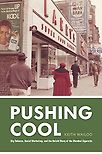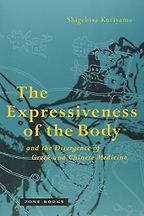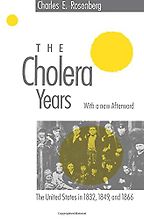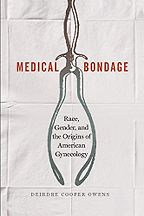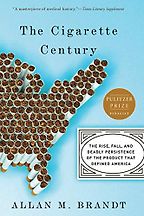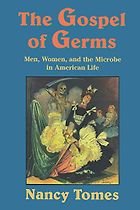Before we get to the books, you are presently president of the American Association for the History of Medicine, so you seem the best person to ask: What is genealogy of this field of study, the history of medicine?
The history of medicine association has its origins almost a hundred years ago. It was founded in 1925, mostly by physicians who were interested in the history of their field. During the sixties and into the 1970s, professional historians, some of whom were medically trained, some of whom were in nursing, but many of whom were PhDs, began to see the history of health and disease and medicine as a potent site for understanding transformations in society. Today the field is occupied by nurses, librarians, physicians, independent scholars, medical school professors, and people who teach in history, medical humanities fields, or even departments in medical schools.
What central narratives dominated the early history of the field?
It’s tempting to caricature the early scholarship; unquestionably there was an element of hagiography. The inclination was to study the history of doctors, the history of discoveries and the major moments in the emergence of modern medicine. Since the 1960s, and in a more pronounced way since the seventies, we’ve seen a focus on themes concerning medicine and society and a pronounced shift toward the history of public health. We’ve seen the focus of the field broaden from doctors to nurses and other health practitioners, and then beyond practitioners to developments in hygiene, diet, and health more generally. Increasingly we’re grappling with questions of diversity of practitioners, health practices, and health experiences in society, and the patient’s experience. Today the field is a microcosm of general trends in history.
I wanted to ask about an early book of yours about the social construction of disease and the medical profession. Please tell me what the history of hematology, which you put under the microscope in Drawing Blood: Technology and Disease Identity in Twentieth Century America, tells us about the history of the United States.
Previous work on the history of hematology—for instance, Blood, Pure and Eloquent, and Hematology, the Blossoming of a Science—was primarily by hematologists and focused on practitioners and their discoveries. I became interested in the broader story of how ideas about blood and blood disease changed by moving beyond this narrow framework.
A good example is a disease called chlorosis, which was widely diagnosed in the 19th century and understood to be a disorder of adolescent girls. Then, by 1920, it was gone. Few people, if any, were diagnosed with chlorosis anymore. What I saw at work in the story of the disappearance of chlorosis was changing ideas about adolescent girls and family doctors who used the chlorosis diagnosis as a basis for the moral management of girls in their practice. As that type of practitioner declined, chlorosis also declined. So, the story of the rise and fall of a disease is not just the story of new discovery. It’s the story of changing social roles, changing social relationships, and changing professional identities, as well as shifting ideas about gender and identity.
“History can be a good guide towards a more equitable and just future”
It was also the story of the evolving role technology plays in medicine. The rise of blood reading technologies, like the hemoglobinometer or the hemocytometer, were also part of that transformation in the role of the family doctor who was being supplanted by these new technology-oriented practitioners. So, it’s a complicated story that highlights that the history of new technologies and new ideas about disease are embedded in social transformations.
Your five books provide a fantastic survey of the field. Let’s begin with a book about the ancient roots of medicine. Shigehisa Kuriyama’s The Expressiveness of the Body and the Divergence of Greek and Chinese Medicine.
Our ideas about medicine are based on theories about how our bodies work. Western medicine developed ways of studying the body, blood flow, muscles, and anatomy. The work of classical practitioners like Galen and Andreas Vesalius laid the basis for Western ideas about the body, and thus medicine. Chinese ancient medicine offers a fascinating contrast, a completely different model of how the body worked.
The Expressiveness of the Body and the Divergence of Greek and Chinese Medicine compares ancient Greek anatomy and medicine with how the body was understood by physicians in ancient China. Kuriyama shows that physicians in China focused less on muscles than pulse and breath. He shows this divergence was part of a broader cultural story, a fundamental schism opening. This schism was expressed in medical treatments, leading the West towards practices like bloodletting and the East towards acupuncture. Kuriyama finds that underlying ideas about volition and the soul also define this split in perceptions of the body. So, the book is about a profound and lasting divergence between Western and Eastern medicine, but it’s also about the role of culture in medicine, in ideas about the body and personhood. It’s a fascinating work.
This book won Kuriyama an award from the American Association for the History of Medicine, the same honor you were awarded for Dying in the City of the Blues: Sickle Cell Anemia and the Politics of Race and Health. Can you please tell me about that work?
Dying in the City of the Blues is the history of sickle cell disease, a disease associated in the United States with African Americans. It’s characterized by painful episodes and was once was defined by very high childhood mortality. My book examines how, in the US, this disease went from being clinically invisible and ignored in the early 20th century, to becoming clinically and socially important by the end of the 1960s, to becoming a widely known disorder seen as, in a sense, a quintessentially African American health concern. I tell the story of the increasing visibility of a disease and how that visibility is part of the unfolding understanding of African American identity, cultural recognition and health politics across the twentieth century.
Turning back to the 19th century, please tell me about The Gospel of Germs by Nancy Tomes.
This book rewrites the history of the germ theory era. The history of major advances in medicine were previously told through the lens of the discoverers, like Louis Pasteur, and discoveries, such as the identification of the pathogen that caused TB. Nancy Tomes pivots to a new history of the germ theory era by examining how ordinary Americans changed their views and behaviors during the late 19th and early 20th century about these invisible microorganisms. The Gospel of Germs is about how bacteriology became relevant in the homes, the kitchens, the churches, and the streets. It’s a story for our moment, as we try to handle conflicting beliefs about the coronavirus.
How did “germ consciousness” reshape society?
Central to Nancy Tomes’s story is how public health reformers promoted the campaign against germs, and how women in particular took up the battle against microbes and invisible pathogens in their defense of the American home. For Tomes, the domestic front was a crucial front where germs and microbes became understood as threats. She also shows how the business sector, and groups like plumbers and others, catered to germ-centered thinking with new household goods and health-oriented appliances, like refrigerators and vacuum cleaners.
Get the weekly Five Books newsletter
You can’t separate out the embrace of germ-centered thinking from the transformation of middle-class life in the late 19th and early 20th century. Tomes shows how these stories played out along the lines of gender, class, ethnicity, and race. She takes a story that we thought we understood, the development of germ theory, and explains how it played out in social life. The title The Gospel of Germs refers to how the belief in germ theory was spread with almost religious zeal by public health reformers. It was a very different moment in the politics of US public health than today, although many aspects of the gospel mentality have endured.
Turning to The Cholera Years: The United States in 1832, 1849, and 1866, please tell me about Charles Rosenberg’s contribution to the social history of medicine.
The Cholera Years, which was published more than 50 years ago, is one of those rare classics that remains an important reference point in the field, still relevant to the politics of public health today. The story is centered in New York, which was a locus of commerce in 1832, in 1849, and in 1866 at the time when three waves of cholera came sweeping across the Atlantic. Then as now, theories of contagion became widely debated. Suddenly, whether you believed in contagion carried enormous economic significance. If you thought that cholera is contagious, you pressed to stop commerce and close ports. For Rosenberg, each cholera outbreak told the story of a changing society—moving from decrying the epidemic as God’s punishment or calling for a day of prayer, to developing new practices associated with the creation of public health. His book examines the moral, religious, and economic aspects of dealing with epidemic disease.
These debates occurred mostly in the pre-bacteriology era, before the identification of microbes as the real enemy. But the book was pioneering in showing how the social response to these three epidemics told, in microcosm, the story of American urban change and secularization. And out of the cholera experience came the creation of the Metropolitan Board of Health in New York City and the idea, ultimately, that every city needs a permanent board of health to safeguard its population.
How did the defeat of cholera lead to the development of public health practices?
The defeat of cholera showed that it was possible to intervene against disease without knowing its cause. One of the iconic developments in the same period was the work of John Snow in London. He discovered that people developing cholera were more likely to be getting water from pumps whose source was a particularly polluted stretch of the Thames, whereas other pumps that were getting water from upstream, where the water had not yet been polluted by human waste, had far fewer cases of cholera. Closing the Broad Street pump was a signal moment in the rise to public health. It showed studying urban processes, such as waste disposal, and understanding water and waste flow, could prevent disease. So, The Cholera Years is a US version of this UK story about the origins of modern public health.
Next, a book about the birth of gynecology and women’s professional medicine. Please tell me about Deirdre Cooper Owens’s Medical Bondage: Race, Gender, and the Origins of American Gynecology.
This book is particularly fascinating to me. Deirdre Cooper Owens reexamines the familiar narrative about modern gynecology techniques like the surgical repair of vesico-vaginal fistulae, a common condition caused in childbirth. These techniques were developed using the bodies of enslaved women or poor women, with J. Marion Sims usually credited for these advances and hailed as the so-called father of modern American gynecology.
Medical Bondage turns the story on its head by focusing on the women whose bodies were the subjects of the research over the years. Owens shows the experiments were part of a history of the misuse of Black bodies and how the research was driven by deep racial misperceptions, such as the idea that Black women were less sensitive to pain when compared to white women. Across gynecology, she shows that Black women and immigrant women were frequently subject to an unforgiving medical gaze that denied their full humanity. And she positions their suffering and sacrifice, as well as their work as nurses, as central to the development of these pioneering experiments. By focusing on the women, rather than J. Marion Sims, she inverts the traditional story of discovery and heroism.
Medical Bondage takes on how racism infects the practice of medicine. The US Centers for Disease Control and entities within 37 out of 50 United States have declared that racism is a public health threat. What are the historical underpinnings of these assessments?
That would take a long time to explain; that question is central not only to my work, but the work of legions of other historians. We’re at a very important moment in society, in healthcare, and in biomedical sciences. Experts are looking closely at how structural racism and racism impinge on health. Fortunately, over the last 30 years an incredible range of scholarship has spoken to this question, documenting how flawed ideas about racial difference led to medical malpractice and maltreatment, examining segregation and its impact on health outcomes, and so on. Historians of medicine have spent decades examining the different ways in which racism and racial hierarchies impact healthcare. In this moment, one hope is that this scholarship will help guide our way to a more just and equitable future for healthcare.
Another brilliant answer to an impossible question. Finally, The Cigarette Century by Allan Brandt. Please tell me about it.
This is a compelling study of how the cigarette industry, an industry that has a very powerful and deeply negative impact on health, developed, endured, and thrived. Whereas historians of medicine often focus on people who are trying to improve the health of the public, Brandt focuses on an industry whose commercial success has been devastating. To explain the cigarette’s deadly persistence, Brandt turns to a wide range of social, political, and economic developments. He examines the history of tobacco advertising, the history of lobbying, as well as the story of how tobacco products were excluded from the regulation to which food and drugs are subject. But the story is also one of science and new regulations—the rise of epidemiological connections between cancer, heart disease and cigarette smoking in the mid-20th century, and new efforts to curtail smoking and the industry’s power and influence. The book is impressive in its scope and offers amazing insights about the interactions of industry, politics, and public health.
Please tell me about how you extend the story of the cigarette industry’s impacts on public health in Pushing Cool.
One underexplored theme in the cigarette century—it’s there, but it’s not as broadly examined as other developments—is the ways in which the tobacco industry targeted different groups of consumers and developed their markets. In Pushing Cool I avail myself of tobacco industry archives that came to light because of lawsuits brought against cigarette companies by state attorneys generals and the Department of Justice in the late nineties. The legal settlement made millions of documents on the industry available, making work like Allan Brandt’s possible, as well as my research on the rise of the menthol cigarette and racial marketing.
Five Books interviews are expensive to produce. If you're enjoying this interview, please support us by donating a small amount.
I track how the false and deceptive promise of health through mentholated smoking first developed in the early 20th century. Then, as cancer and heart disease became more and more linked to smoking, menthol and filtered cigarettes rose in popularity. It was in the 1960s that industry pivoted to racial marketing of menthols, pushing various brands more aggressively to the Black inner city. In Pushing Cool I grapple with why and how these pivots happened. There are some surprises in the story, such as the fact that when the industry was pushed by government efforts to curtail cigarette advertising to youth, they began in earnest to look for new urban markets.
Brandt shows how the development of medical disinformation and cultural resistance to medical expertise were incubated by the industry. Did the cigarette industry spark the sort of defiance that we see in mass vaccination opposition?
Allan Brandt and Robert Proctor, another important cigarette historian, developed an excellent critique of the tobacco industry. Proctor argues that one of the main products of the tobacco industry was doubt and skepticism about the science. They both focus on the ways the industry manufactured doubt about the link between cigarettes and cancer, between tobacco use and heart disease. The industry sowed skepticism towards science and medical expertise that became part of political and popular culture. Other historians, like Naomi Oreskes, have pointed out how this industry strategy also informs climate science denialism. While the anti-vaccination skepticism has slightly different origins, the sentiment and what Robert Proctor called ‘agnotology’, the science of doubt, travel a similar path with other forms of denialism.
In my book, I looked at a different aspect of industry-sponsored science; not those who undermined science, but the social scientists who worked for the industry, and how cigarette companies used consumer psychology to study health anxieties, desires for safety, and how to pitch filters and menthol to a health-anxious population. I look at how psychology and science helped industry develop markets.
Your choices help us see the long arc of medical history in the United States in particular. Can you tell how that arc is bending? Is it in the direction of justice and progress or health outcome inequality and resistance to medical science?
Historians are not futurists, but I would say that we’re in a hopeful moment. One can always hope and be wary at the same time, while also working for equity and justice in our medical and healthcare systems. That’s all I can say.
If you were less modest, you could say that the history of medicine plays a role in that work.
I will say that history can be a good guide towards a more equitable and just future.
Interview by Eve Gerber
November 8, 2021. Updated: March 1, 2022
Five Books aims to keep its book recommendations and interviews up to date. If you are the interviewee and would like to update your choice of books (or even just what you say about them) please email us at [email protected]

